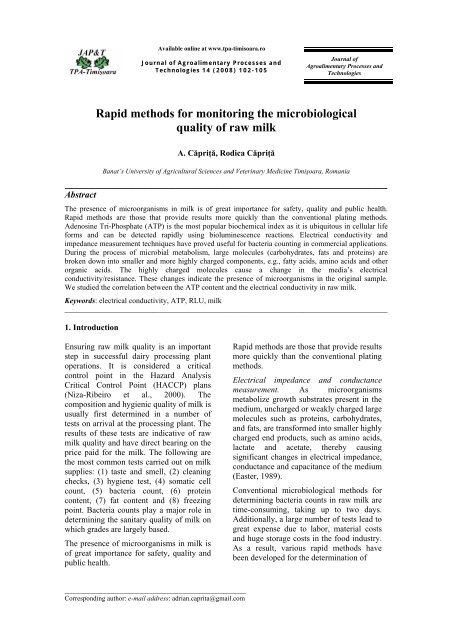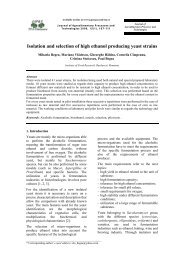Rapid methods for monitoring the microbiological quality of raw milk
Rapid methods for monitoring the microbiological quality of raw milk
Rapid methods for monitoring the microbiological quality of raw milk
Create successful ePaper yourself
Turn your PDF publications into a flip-book with our unique Google optimized e-Paper software.
A. Căpriţă et al ./ Journal <strong>of</strong> Agroalimentary Processes and Technologies 14 (2008)bacteria counts in <strong>the</strong> past several decades,including ATP estimations (Niza-Ribeiro etal., 2000), direct epifluorescent filtertechnique (Rosmini et al., 2004) andelectrical <strong>methods</strong> (Yang et al., 2004;Felice et al., 1999). The ATP method andepifluorescent filter method are fast butcomplicated.Electrical <strong>methods</strong> are simple but requirean expensive instrument. Impedancemicrobiology (Firstenberg-Eden, 1984)was one <strong>of</strong> <strong>the</strong> earliest electrical <strong>methods</strong><strong>for</strong> <strong>the</strong> detection <strong>of</strong> bacteria in foods, andhas been developed as a rapid method thatcan detect bacteria within 24 h (Silley,1996). It is based on <strong>the</strong> measurement <strong>of</strong>changes in electrical impedance <strong>of</strong> amedium or a reaction solution resultingfrom <strong>the</strong> growth <strong>of</strong> bacteria. The majority<strong>of</strong> previous studies on <strong>the</strong> determination <strong>of</strong>bacterial counts have focused on <strong>the</strong>modification <strong>of</strong> <strong>the</strong> medium, aiming at <strong>the</strong>optimization <strong>of</strong> <strong>the</strong> electrical signals(Easter, 1985) or supporting <strong>the</strong> selectivegrowth <strong>of</strong> target bacteria against o<strong>the</strong>rbacteria. The impedance method wasapproved as an <strong>of</strong>ficial method <strong>for</strong> <strong>the</strong>detection <strong>of</strong> Salmonella in foods by <strong>the</strong>Association <strong>of</strong> Analytical Communities(AOAC) (Yang et al., 2004). Recentstudies have focused on <strong>the</strong> separatemeasurements <strong>of</strong> impedance change in <strong>the</strong>electrode and medium components <strong>for</strong> <strong>the</strong>rapid detection <strong>of</strong> bacteria in foods (Yanget al., 2004; Ong et al., 2001) known asimpedance-splitting (IS) <strong>methods</strong>. Felice etal. (1999) reported an IS method based on<strong>the</strong> measurement <strong>of</strong> <strong>the</strong> change in <strong>the</strong>electrode interface capacitance duringbacteria growth <strong>for</strong> <strong>the</strong> quantification <strong>of</strong>bacteria in <strong>milk</strong>.Conventional conductivity and impedancemeasurement techniques have proved to beuseful <strong>for</strong> bacteria counting in commercialapplications (Felice et al., 1999; Silley,1996). Devices based on <strong>the</strong>se techniquesmonitor microbial metabolism in a growthmedium by immersing electrodes directlyinto <strong>the</strong> medium and measuring <strong>the</strong>permittivity and/or conductivity (Ong etal., 2001).Despite <strong>the</strong>ir widespread application, <strong>the</strong>setechniques have many disadvantagesincluding polarization <strong>of</strong> <strong>the</strong> probeelectrodes, decreased sensitivity <strong>of</strong> <strong>the</strong>device in more conductive media and <strong>the</strong>high cost <strong>of</strong> instruments used.Adenosine Tri-Phosphate (ATP) is <strong>the</strong>most popular biochemical index as it isubiquitous in cellular life <strong>for</strong>ms and can bedetected rapidly using bioluminescencereactions. Bioluminescence is <strong>the</strong> emission<strong>of</strong> light by biological <strong>methods</strong> usingLuciferase enzyme (Griffiths, 1993).Luciferase, toge<strong>the</strong>r with its co-factors D-Luciferin and oxygen, produces light in <strong>the</strong>presence <strong>of</strong> ATP according to <strong>the</strong> followingreaction:Luciferase + D-Luciferin + O 2 + ATP → Luciferase+ oxy-luciferin + CO 2 + + AMP + PPi + LightThe amount <strong>of</strong> light is proportional to <strong>the</strong>concentration <strong>of</strong> ATP in <strong>the</strong> originalsample. The ATP concentration in a sampleis, in turn, related to <strong>the</strong> number and types<strong>of</strong> organisms within <strong>the</strong> sample. Thus arelative index <strong>of</strong> <strong>the</strong> amount <strong>of</strong>contamination can be generated usingfirefly bioluminescence within a fewminutes <strong>of</strong> sampling. O<strong>the</strong>r chemicals canbe used to index <strong>the</strong> levels <strong>of</strong> microbialcontamination in addition to ATP.3. Material and <strong>methods</strong>The experiments were carried out on <strong>milk</strong>samples d<strong>raw</strong>n from 12 dairy cows.The electrical conductance <strong>of</strong> <strong>the</strong> <strong>milk</strong>samples was measured with conductivitymeter type OK-102/1 (Radelkis).The instrument was standardized with KClsolutions <strong>of</strong> known conductance be<strong>for</strong>e use.The cell was washed with 0.01 M KClfollowed by one to two rinses with <strong>the</strong>sample prior to measurement. Temperaturecorrections were made, as <strong>the</strong> samples werenot analyzed at 25°C.In our experiments, <strong>the</strong> ATP determinationwas carried out with an apparatus (BioscanMonitor RHS 055) and products from <strong>the</strong>Betz Dearborn Company.103
A. Căpriţă et al ./ Journal <strong>of</strong> Agroalimentary Processes and Technologies 14 (2008)For all <strong>the</strong> stages, followedprotocols are those prescribed by thiscompany. The photometer produces someRelative Light Unit (RLU) during <strong>the</strong>enzymatic reaction. The Bioscan MonitorRHS 055 employs a sampling pen, whichfacilitates precise sampling, eliminating <strong>the</strong>need to mix and measure reagents, andfunctions as <strong>the</strong> measurement cell <strong>for</strong> <strong>the</strong>luminometer. A total ATP sampling penconsists <strong>of</strong> <strong>the</strong> following parts: -a stick <strong>for</strong>accurate sampling <strong>of</strong> <strong>the</strong> liquid to be tested,coated with an extractant, which releaseATP from cellular material; <strong>the</strong> stick alsotransfers <strong>the</strong> sample into <strong>the</strong> cuvette; -acuvette filled with test buffer <strong>for</strong> dilution,buffering and neutralization <strong>of</strong> <strong>the</strong> sample;-a reagent chamber sealed with aluminiumfoil, containing freeze-dried and stabilizedluciferin/luciferase reagent.4. Results and DiscussionIn our previous studies (Caprita et al., 2007)we observed <strong>the</strong> best correlation betweenRLU and <strong>the</strong> SCC and CFU sum in <strong>raw</strong> <strong>milk</strong>(r=0.9590). The electrical conductivity values<strong>of</strong> <strong>the</strong> same <strong>milk</strong> samples show that <strong>the</strong> RLUand <strong>the</strong> electrical conductivity values arehighly correlated (r = 0.9553).These two rapid <strong>methods</strong> can be used in<strong>monitoring</strong> <strong>the</strong> <strong>microbiological</strong> <strong>quality</strong> <strong>of</strong> <strong>raw</strong><strong>milk</strong>. The electrical conductivity assay has <strong>the</strong>disadvantage <strong>of</strong> being induced also by <strong>milk</strong>acidification (Caprita, 2007).El. cond. (mS/cm)5.35.25.154.94.84.74.6y = 1.7171x - 2.6371R 2 = 0.91274.54.1 4.2 4.3 4.4 4.5 4.6 4.7log RLUFigure 1. The correlation between RLU and <strong>the</strong> electrical conductivity4. ConclusionsThe bioluminescence assay <strong>of</strong> ATP and <strong>the</strong>electrical conductivity assay are very rapid,non-polluting <strong>methods</strong>.There is positive correlation between<strong>milk</strong> ATP and electrical conductivity(r= 0.9553).Both <strong>methods</strong> can be used <strong>for</strong> <strong>monitoring</strong><strong>the</strong> <strong>microbiological</strong> <strong>quality</strong> <strong>of</strong> <strong>raw</strong> <strong>milk</strong>.ReferencesCaprita, A., Caprita, R., Vintila, T. (2007). TheATP assay, a method <strong>for</strong> measuring biologicalactivity in <strong>raw</strong> <strong>milk</strong>. Proceedings <strong>of</strong> 5thInternational Congress on Food Technology,Thessaloniki, 9-11 mar., vol. 2, 500-505.Caprita A., Caprita, R. (2007). Physico-chemicalchanges during <strong>milk</strong> fermentation.Proceedings <strong>of</strong> <strong>the</strong> International Conference„Agricultural and Food Sciences Processesand Technologies”, Sibiu, 26-27 apr., 171-174.104
A. Căpriţă et al ./ Journal <strong>of</strong> Agroalimentary Processes and Technologies 14 (2008)Easter, M. C., Gibson, D. M. (1989). Detection<strong>of</strong> microorganisms by electricalmeasurements. In M. R. Adams and C. F.A. Hope, <strong>Rapid</strong>s Methods in foodMicrobiology. Amsterdam: Elsievier Sci.Publ.Felice, C.J., Madrid, R.E., Olivera, J.M.,Rotger, V.I., Valentinuzzi, M.E., (1999).Impedance microbiology: quantification <strong>of</strong>bacterial content in <strong>milk</strong> by means <strong>of</strong>capacitance growth curves. J. Microbiol.Methods. 35, 37–42.Firstenberg-Eden, R., Zindulis, J. (1984).Electrochemical changes in media due tomicrobial growth. J. Microbiol. Methods,2, 103–115.Griffiths, M. W. (1993). Applications <strong>of</strong>bioluminescence in <strong>the</strong> dairy industry. J.Dairy Sci., 76, 3118-3125.Niza-Ribeiro, J., Louza, A. C., Santos, P.,Lima, M. (2000). Monitoring <strong>the</strong><strong>microbiological</strong> <strong>quality</strong><strong>of</strong> <strong>raw</strong> <strong>milk</strong> through <strong>the</strong> use <strong>of</strong> an ATPbioluminescence method. Food Control, 11,209–216.Rosmini, M. R., Signorini, M. L., Schneider, R.,Bonazza, J. C. (2004). Evaluation <strong>of</strong> twoalternative techniques <strong>for</strong> counting mesophilicaerophilic aerobic bacteria in <strong>raw</strong> <strong>milk</strong>. FoodControl. 15, 39–44.Ong, K. G., Wang, J., Singh, R. S., Bachas, L. G.,Grimes, C. A. (2001). Monitoring <strong>of</strong> bacteriagrowth using a wireless, remote queryresonant-circuit sensor: application toenvironmental sensing. Biosens. Bioelectron.16, 305–312.Silley, P., Forsy<strong>the</strong>, S., (1996). Impedancemicrobiology—a rapid change <strong>for</strong>microbiologists. J. Appl. Bacteriol. 80, 233–243.Yang, L., Li, Y., Griffis, C. L., Johnson, M. G.,(2004). Interdigitated microelectrode (IME)impedance sensor <strong>for</strong> <strong>the</strong> detection <strong>of</strong> viable,Salmonella typhimurium. Biosens.Bioelectron. 19, 1139–1147.105
















